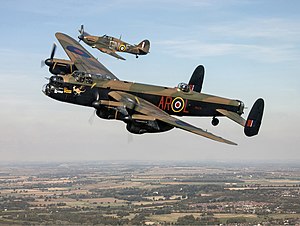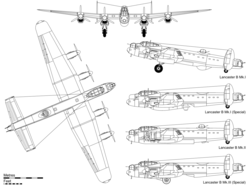Avro 683 Lancaster
| Lancaster | |
|---|---|

| |
| Lancaster B I PA474[a] of the RAF Battle of Britain Memorial Flight in 460 Squadron (RAAF) colours, escorted by Hurricane Mk.IIc LF363. | |
| Role | Heavy bomber |
| National origin | United Kingdom |
| Manufacturer | Avro |
| Designer | Roy Chadwick |
| First flight | 9 January 1941 |
| Introduction | February 1942 |
| Status | Retired |
| Primary users | Royal Air Force Royal Canadian Air Force Royal Australian Air Force |
| Number built | 7,377[1] |
| Unit cost | |
| Developed from | Avro Manchester |
| Variants | Avro Lancastrian |
| Developed into | Avro York Avro Lincoln |
Avro 683 Lancaster was developed out of Avro 679 Manchester. It was the most used RAF bomber in the Second World War. The changes made on Avro 679, like four Rolls-Royce Merlin X instead of two powerplants and longer wings, have led to the new name Avro 683. Royal Air Force ordered 1070 pieces of this airplane. After the success on the war places, Avro sold the production licence to other companies. One of those was Packard, who bought the licence for powerplant production and improved them. The variant with the most produced pieces was Avro 683 B I, a plane which was the base of RAF Bomber Command at that time.

Technical data (Lancaster B I)
| Data | Units |
|---|---|
| Years of production | 1941-1946 |
| Manufacturer | Avro |
| Wingspan | 31 m |
| Length | 21,10 m |
| Hight | 6,10 m |
| Wing area | 120,50 m² |
| Weight (empty) | 16.740 kg |
| Max takeoff weight | 31.750 kg |
| Passengers | - |
| Crew | 7 |
| Speed | 462 km/h |
| Service ceiling | 7.470 m |
| Range | 4.070 km |
| Powerplant | 4*Rolls-Royce Merlin X |
References
- ↑ Norris 1966, pp. 13–14.
Notes
- ↑ This aircraft carries the deepened bomb aimer blister (Mod. 780) and the later paddle-bladed propellers. Neither H2S blister nor exhaust shrouds are fitted.
Other websites
- 20./21. February 1945 - The last flight of RAF PD421 IQ-F. Historical research of an Avro 683 lost near Hagen, Germany[permanent dead link] German
Wikimedia Commons has media related to Avro Lancaster.